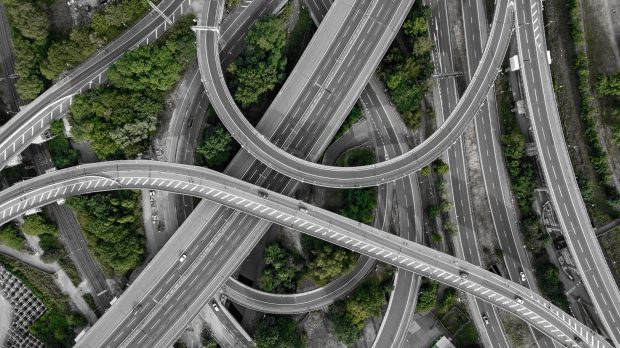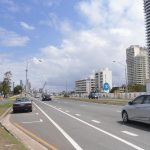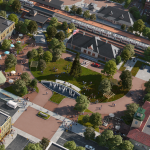New Jersey Future Blog
NJ Stay-at-Home Order is Reducing GHG Emissions
April 15th, 2020 by Tim Evans
New Jerseyans are staying at home — and reducing greenhouse gas emissions
 On March 21st, the order went out to the whole state of New Jersey: Stay at home to the greatest extent possible. The order meant to help suppress the spread of the COVID-19 virus by minimizing person-to-person contact. New Jersey was one of the earliest states in the nation to issue statewide school-closing and stay-at-home orders, according to the University of Washington’s Institute for Health Metrics and Evaluation, which has been tracking state government efforts to slow the spread of the virus.
On March 21st, the order went out to the whole state of New Jersey: Stay at home to the greatest extent possible. The order meant to help suppress the spread of the COVID-19 virus by minimizing person-to-person contact. New Jersey was one of the earliest states in the nation to issue statewide school-closing and stay-at-home orders, according to the University of Washington’s Institute for Health Metrics and Evaluation, which has been tracking state government efforts to slow the spread of the virus.
New Jersey’s citizens have risen to the challenge. According to the traffic data analysis consultant INRIX, which has been monitoring the decline in travel volumes across the country in response to states’ physical-distancing orders, New Jersey is #1 in staying at home, notching a 63 percent drop in statewide personal vehicle travel as of last week, when compared to the baseline week of February 22nd.
Obviously, a major component in achieving such a dramatic reduction in vehicular travel is having as many people as possible work from home. New Jersey was not previously a national leader in telecommuting; as of the 2017 one-year American Community Survey, only 4.6 percent of employed New Jersey residents worked at home, compared to 5.2 percent nationally, and far behind Colorado, Oregon, and Vermont, all of which have rates exceeding 7 percent. In a sense, New Jersey had more room for improvement on this score than a lot of other states.
One side benefit of all of this non-driving is cleaner air, thanks to fewer cars on the road. Whether it’s drone footage of virtually empty streets in Philadelphia, or a dashboard-cam cruise around some of New York’s iconic (and now-deserted) streets and intersections, or stories about blue skies over famously-smoggy Los Angeles or Delhi, India or major Chinese cities, popular media outlets are enjoying pointing out what major cities look like when stripped of their traffic and the pollution it creates.
Besides producing fewer particulate pollutants of the kind that result in smog, the big drop in car travel also means less CO2 is being pumped into the atmosphere. This point is less obvious from photographic and video evidence, since CO2 doesn’t visibly make the air dirtier, isn’t directly harmful to breathe, and is not what many people traditionally think of as a “pollutant.”
But CO2 is the most plentiful of the greenhouse gases (GHGs) that trap heat in the atmosphere and lead to climate change and sea-level rise, which pose particular risks to coastal states like New Jersey. And the transportation sector accounts for the biggest share of total GHG emissions, both nationally, where it contributes 29 percent of all GHG emissions, and in New Jersey, where it is responsible for an even higher 42 percent of the total. Most transportation emissions are a byproduct of moving people and things from one place to another, mainly by car and truck.
Reducing vehicle-miles traveled (VMT)—the amount of driving being done by all those cars and trucks—is thus an important strategy for reducing GHG emissions. A land-use approach to reducing VMT entails building things closer together, reducing the distances required to travel among destinations. It means creating more compact, walkable, mixed-use and transit-connected places, where some trips can be taken on foot or by public transit, and where trip distances are shorter for trips that are still taken by car.
Working from home is also, as the INRIX data illustrate, an effective strategy for reducing VMT. When home and work—the two most frequently visited destinations for the average employed person—are merged into the same physical location, the distance required to travel between them is reduced to zero. Consider that if every regular car commuter in New Jersey were able to work from home just one day a week, this would cut work-related VMT—and its associated GHG emissions—by 20 percent. This would amount to a reduction in GHG emissions equivalent to having 20 percent of the workforce commuting in electric vehicles, which right now remains a highly aspirational and ambitious goal.
Electrifying 20 percent of the vehicle fleet is not going to happen overnight. But New Jersey has achieved, practically overnight, an even more dramatic reduction in vehicular emissions. It can be done, and we did it without changing anything about the vehicle fleet or the road network. Of course, this dramatic reduction has happened as a consequence of a broader containment effort that has imposed significant economic costs and significant disruptions to people’s daily lives. But when the immediate COVID-19 danger has receded and things begin to return to normal, it is worth discussing how much of our normal work-related VMT is really necessary, after all.
It is worth discussing how much of each person’s work actually needs to be done on site, and how much can be done remotely. It is worth discussing how many staff meetings require everyone to be in the office and how many could be conducted via video conferencing apps, the use of which has experienced meteoric growth compared to pre-pandemic levels. It is worth discussing how much of our economic output could potentially continue to chug along without nearly so much driving. Besides fostering more compact, walkable land development patterns and electrifying vehicle fleets, telecommuting deserves a serious look as a longer-term GHG reduction strategy.
Related Posts
Tags: COVID-19, Driving, Transit, travel
















